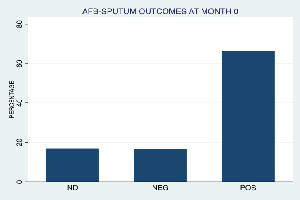Assessment of Drug-Resistant Tuberculosis within the Decentralized Health System in Kenya and the Associated Treatment Outcomes
Authors
##plugins.themes.bootstrap3.article.main##
Abstract
Background: In Kenya, health is a devolved function that county governments run. Tuberculosis is managed at the county level in coordination with the National Leprosy Tuberculosis and Lung Disease Program (NLTP), which has a mission of End TB Strategy to achieve a 95% decline in deaths due to tuberculosis compared with the 2015 baseline and reach an equivalent 90% reduction in tuberculosis incidence rate. Methods: This was a retrospective study that included patients who tested positive for drug-resistant tuberculosis from 2014 to 2019. Data was sourced from NLTP Electronic Medical Records. After abstraction, the data was entered into Excel and analyzed through STATA software version 13. Results: Of the 2674 enrolled patients in total, there were more males affected with DRTB at 64 % compared to the female patients. The public facilities carried the immense burden of diagnosis and treatment of the patient, having a cumulative number of 83 %, while the prison sector had the lowest number. For the resistance pattern, the new, relapse, and failure of first-line drugs accounted for most drug-resistant cases at 80 %, with only 65 % of the total cases having been done a gene-expert test at the point of screening. Conclusion: Kenya's devolved health system needs more coordinated support from the national government to the county health units for TB surveillance. Regional centralized laboratories for diagnosis and monitoring of TB would reduce the time it takes for samples to come to Nairobi for testing, which takes time before patents are initiated on treatment.
##plugins.themes.bootstrap3.article.details##
Copyright (c) 2024 Mutabari David, Dr. Idah Orowe, Dr. Anthony Karanja, Dr. Hillary Kipruto

This work is licensed under a Creative Commons Attribution 4.0 International License.
Creative Commons License All articles published in Annals of Medicine and Medical Sciences are licensed under a Creative Commons Attribution 4.0 International License.
Williamson T, Mulaki A. Devolution of Kenya’s health system - The role of Health Policy Project. Policy Br [Internet]. 2015;(January):8. Available from: https://www.healthpolicyproject.com/pubs/719_KenyaDevolutionBrief.pdf
NSP. The National Strategic Plan for Tuberculosis, Leprosy and Lung Health 2019 - 2023. 2023; Available from: https://www.chskenya.org/wp-content/uploads/2019/04/National-Strategic-Plan-2019-2023.pdf
Tuberclosis S. Stop tuberclosis. 2022;(April):2016-9.
Iacobino A, Fattorini L, Giannoni F. Drug-resistant tuberculosis 2020: Where we stand. Appl Sci. 2020;10(6):1-17.
Fu H, Lewnard JA, Frost I, Laxminarayan R, Arinaminpathy N. Modelling the global burden of drug-resistant tuberculosis avertable by a post-exposure vaccine. Nat Commun [Internet]. 2021;12(1):1-9. Available from: http://dx.doi.org/10.1038/s41467-020-20731-x
Coverage UH. Tuberculosis in the WHO African Region: 2023 progress update Tuberculosis in the WHO African Region: 2023 progress update. 2023;(September).
Naidoo K, Perumal R, Cox H, Mathema B, Loveday M, Ismail N, et al. The epidemiology, transmission, diagnosis, and management of drug-resistant tuberculosis— lessons from the South African experience. Lancet Infect Dis [Internet]. 2024 Apr 26; Available from: https://doi.org/10.1016/S1473-3099(24)00144-0
Mutabari D, Orowe I, Karanja A, Kipruto H. Insights of Bioinformatics Retrospective Analysis of Drug-Resistant Tuberculosis and the Associated Treatment Outcomes in Kenya. Insights Bioinforma [Internet]. 2022;2(1):21-9. Available from: https://scholars.direct/Articles/bioinformatics/ibi-2-002.php?jid=bioinformatics
Report GT. Kenya Tuberculosis Roadmap Overview, Fiscal Year 2021. 2023;1-5.
Long R, Divangahi M, Schwartzman K. Chapter 2: Transmission and pathogenesis of tuberculosis. Can J Respir Crit Care, Sleep Med [Internet]. 2022;6(S1):22-32. Available from: https://doi.org/10.1080/24745332.2022.2035540
Bierrenbach A. Background paper number 9 Estimating the burden of TB by age and sex: data availability, gaps and next steps. 2016;(9):1-16.
Summary E. WHO Guideline: Nutritional care and support for patients with tuberculosis i Nutritional care and support for patients with tuberculosis Executive Summary Guideline: WHO Guideline: Nutritional care and support for tuberculosis ii. Nutr care Supports patients with Tuberc. 2014; WHO/NMH/NH.

